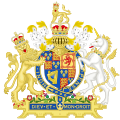- Clarendon Ministry
-
The Clarendon Ministry was forged out of the royalist camp of Charles II, who was returned to the throne (the English Restoration) in 1660. Two years previously, Lord Hyde (later Earl of Clarendon) had been appointed Lord Chancellor, and in 1660, he was joined by several other powerful statesmen, including the heir presumptive of the English throne, the Duke of York. After the Second Anglo-Dutch War, however, Charles lost confidence in his ministers, and in 1667, five statesmen took cooperative power in the Cabal Ministry.
Lord Clarendon was impeached by the House of Commons and forced to flee; the Duke of Albemarle sold his position to George Villiers, 2nd Duke of Buckingham; and Sir George Carteret simply left his position, eventually being forced out of the House two years later.
Committee for Foreign Affairs
The Privy Council Committee for Foreign Affairs served as the Ministry; other significant statesmen not in the committee are listed in the next section. As the name of the ministry would suggest, Lord Clarendon (earlier Lord Hyde) was, in effect, the leader of the government.
Office Name Term Notes Lord Chancellor The Lord Hyde 1660–1667 appointed 1658; created Earl of Clarendon in 1661 Lord High Treasurer The Earl of Southampton 1660–1667 died before government was dissolved Lord Steward The Duke of Ormonde 1660–1667 also Lord Lieutenant of Ireland (1662–1668) Master of the Horse The Duke of Albemarle 1660–1667 also Lord Lieutenant of Ireland (1660–1662) Southern Secretary Sir Edward Nicholas 1660–1662 appointed 1654 Sir Henry Bennet, Bt. 1662–1667 created Baron Arlington in 1664 Northern Secretary Sir William Morice 1660–1667 created a baronet in 1661 Secretary to the Admiralty Sir William Coventry 1665–1667 Ministers not in Committee
Office Name Term Notes Lord Privy Seal The Lord Robartes 1661–1667 Lord High Admiral Prince James, Duke of York 1660–1667 Lord Chamberlain The Earl of Manchester 1660–1667 Secretary of State for Scotland The Earl of Lauderdale 1660–1667 Chancellor of the Exchequer The Lord Ashley 1661–1667 Treasurer of the Navy Sir George Carteret, Bt. 1660–1667 also Vice-Chamberlain of the Household Charles II (1660–1685) Clarendon Ministry · Cabal Ministry · First Danby ministry · Privy Council Ministry · First Rochester ministry · Godolphin MinistryJames II (1685–1688) Second Rochester Ministry · Belasyse MinistryWilliam and Mary (1689–1694) William III (1694–1702) Anne (1702-1714) History of England category Categories:- Political history of England
- English ministries
- 17th century in England
- 1660 establishments in England
- 1667 disestablishments
- Ministries of Charles II of England
Wikimedia Foundation. 2010.

